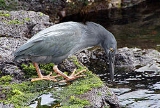
Lava Heron
Encyclopedia
The Lava Heron, Butorides sundevalli, also known as the Galapagos Heron, is a species
of heron
endemic to the Galapagos Islands
. The adult is slate-grey, which helps it blend in with the hardened lava
. The back feathers typically have a silvery sheen and it has a short crest on its head. When breeding, the heron has a black beak and bright orange legs, but they fade to grey after the breeding season. Lava Herons are typically seen hunched over and they have a sharp alarm call. These highly territorial birds are found in intertidal zone
s and mangrove groves
on all of the Galapagos islands.
The Lava Heron stalks small crabs and fish
slowly before quickly spearing and eating them. They have also been known to eat the flies that gather near cacti
. Unlike most herons, these birds nest in solitary pairs in either the lower branches of mangrove trees or under lava rocks. They can breed year-round, though typically from September to March, and can mate up to three times a year. These birds have no fear of humans.
This heron is considered a subspecies (or even just a colour morph) of the Striated Heron
B. striata by some authorities (including the AOU
and BirdLife International
), and was formerly "lumped" with this species and the Green Heron
B. virescens as the Green-backed Heron
B. striatus.
Species
In biology, a species is one of the basic units of biological classification and a taxonomic rank. A species is often defined as a group of organisms capable of interbreeding and producing fertile offspring. While in many cases this definition is adequate, more precise or differing measures are...
of heron
Heron
The herons are long-legged freshwater and coastal birds in the family Ardeidae. There are 64 recognised species in this family. Some are called "egrets" or "bitterns" instead of "heron"....
endemic to the Galapagos Islands
Galápagos Islands
The Galápagos Islands are an archipelago of volcanic islands distributed around the equator in the Pacific Ocean, west of continental Ecuador, of which they are a part.The Galápagos Islands and its surrounding waters form an Ecuadorian province, a national park, and a...
. The adult is slate-grey, which helps it blend in with the hardened lava
Lava
Lava refers both to molten rock expelled by a volcano during an eruption and the resulting rock after solidification and cooling. This molten rock is formed in the interior of some planets, including Earth, and some of their satellites. When first erupted from a volcanic vent, lava is a liquid at...
. The back feathers typically have a silvery sheen and it has a short crest on its head. When breeding, the heron has a black beak and bright orange legs, but they fade to grey after the breeding season. Lava Herons are typically seen hunched over and they have a sharp alarm call. These highly territorial birds are found in intertidal zone
Intertidal zone
The intertidal zone is the area that is above water at low tide and under water at high tide . This area can include many different types of habitats, with many types of animals like starfish, sea urchins, and some species of coral...
s and mangrove groves
Mangrove
Mangroves are various kinds of trees up to medium height and shrubs that grow in saline coastal sediment habitats in the tropics and subtropics – mainly between latitudes N and S...
on all of the Galapagos islands.
The Lava Heron stalks small crabs and fish
Fish
Fish are a paraphyletic group of organisms that consist of all gill-bearing aquatic vertebrate animals that lack limbs with digits. Included in this definition are the living hagfish, lampreys, and cartilaginous and bony fish, as well as various extinct related groups...
slowly before quickly spearing and eating them. They have also been known to eat the flies that gather near cacti
Cacti
-See also:* RRDtool The underlying software upon which Cacti is built* MRTG The original Multi Router Traffic Grapher from which RRDtool was "extracted".* Munin -External links:******...
. Unlike most herons, these birds nest in solitary pairs in either the lower branches of mangrove trees or under lava rocks. They can breed year-round, though typically from September to March, and can mate up to three times a year. These birds have no fear of humans.
This heron is considered a subspecies (or even just a colour morph) of the Striated Heron
Striated Heron
The Striated Heron, Butorides striata, also known as Mangrove Heron, Little Heron or Green-backed Heron, is a small heron. Striated Herons are mostly non-migratory and noted for some interesting behavioral traits. Their breeding habitat is small wetlands in the Old World tropics from west Africa to...
B. striata by some authorities (including the AOU
American Ornithologists' Union
The American Ornithologists' Union is an ornithological organization in the USA. Unlike the National Audubon Society, its members are primarily professional ornithologists rather than amateur birders...
and BirdLife International
BirdLife International
BirdLife International is a global Partnership of conservation organisations that strives to conserve birds, their habitats and global biodiversity, working with people towards sustainability in the use of natural resources...
), and was formerly "lumped" with this species and the Green Heron
Green Heron
The Green Heron is a small heron of North and Central America. It was long considered conspecific with its sister species the Striated Heron , and together they were called "Green-backed Heron"...
B. virescens as the Green-backed Heron
Green-backed Heron
"Green-backed Heron" is a collective term for certain herons. Small and compact among herons, these birds often feature green plumage – rare among the Ardeidae –, in particular on the back, wings and scapulars....
B. striatus.

